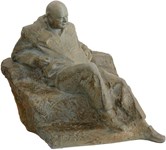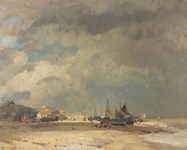
Few regions can boast an artistic heritage quite like East Anglia’s. Its extensive landscapes and sweeping coastlines have inspired a strong succession of home-grown talent – from John Constable to Alfred Munnings and beyond – and resulted in the East Anglian tradition becoming one of the best established on the UK art market.
Norfolk auction house Keys (20% buyer’s premium) caters to the demand for the region’s painters by holding a sale devoted to East Anglian art twice a year. It covers mainly 19th and 20th century material from the many schools, groups and traditions that make up the category and offers a broad choice of pictures to suit most pockets.
Local demand from “a strong group of private buyers on the hunt for good artwork to redecorate their period properties” is also high, says Keys managing director David Broom.
Must-have name
The 19th century painter Eloise Harriet Stannard (1829-1915) was among the must-have names in the October 25 sale in Aylsham.
The daughter of landscape and marine painter Alfred Stannard, she focused on flower and fruit subjects in the style of traditional Dutch still-life painting with a particular emphasis on exotic fruits such as pineapples and pomegranates.
She regularly exhibited works at the Royal Academy between 1856-93 and was one of only two notable women artists associated with the Norwich School of painters, Britain’s first provincial art movement. Her aunt Emily Coppin Stannard, also a painter of still-lives, was the other.
Rather rare for women painters of the 19th century, Eloise Stannard was considered one of the best of her genre and was celebrated during her lifetime for the high quality, colour and the detailed realism of her still-lives. Her success was such that she never needed to take in pupils, as was often the case for 19th century women artists.
The signed 20in (51cm) square still-life offered at Keys depicted mixed fruit including a sliced pineapple and a Norwich silver jug and was dated to 1896. A trade consignment believed not have been offered at auction in recent memory, it drew multiple phone bids before it was sold over top estimate to a private UK collector of East Anglian art for £13,000.
A smaller still-life by Stannard depicting raspberries in a basket on a marble ledge made £1200 against an estimate of £1250-1500.
Stannard’s prices have declined since the 1990s when interest in 19th century art was at a high, says Broom, but strong prices can still be attained for her best works.
Five of her top prices at auction came in the 1990s for works that predated 1873, the year her mother died and she took over running the family. Though she worked continuously in the studio into old age, there was a decline in her earlier productivity and her paintings became smaller.
Seago watch
Among East Anglia’s greatest artistic exports of the 20th century is Edward Seago (1910-74) whose late Impressionistic landscapes of Norfolk, London and Europe continue to be hot property among Modern British collectors.
The Watchtower at Hoorn, Holland was the sole Seago entry at Keys and was painted on one of several sailing trips the artist made to the Low Countries. The 20in x 2ft 6in (51 x 76cm) oil on canvas had provenance to Colnaghi.















